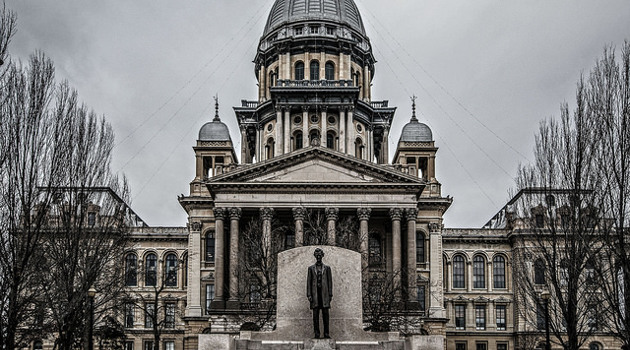Last year, I said the nation’s most important referendum was the proposal to emasculate Colorado’s Taxpayer Bill of Rights (I was delighted when voters said no to the pro-spending lobbies and preserved TABOR).
 This year’s most important referendum is taking place in November in Illinois, where pro-spending lobbies are very anxious to repeal the state’s flat tax.
This year’s most important referendum is taking place in November in Illinois, where pro-spending lobbies are very anxious to repeal the state’s flat tax.
If they succeed, the steady flow of taxpayers out of Illinois will become a torrent.
That’s because the flat tax is the only semi-decent feature of the state’s fiscal policy. If it goes, there won’t be any hope.
My buddy from the Illinois Policy Institute, Orphe Divounguy, has a column in today’s Wall Street Journal about the dismal fiscal and economic outlook in the Land of Lincoln.
Long the economic hub of the Midwest, Illinois has lost more than 850,000 residents to other states during the past decade. The state has been shrinking for six consecutive years and suffered the largest raw population decline of any state in the 2010s.
…Growing government debt and a crushing tax burden are depressing economic growth. State spending is up, but personal-income growth is lagging. Since 2000, Illinois’s per capita personal income growth has been 21% lower than the national average. …ratings firms are paying attention. Illinois’s credit rating is one notch above junk. …Illinois’s public pension payments already consume nearly a third of the state budget, yet the unfunded liability—which the state currently pegs at $137 billion, though others put the figure much higher—continues to rise. …Since 2000, Illinois has increased pension spending by more than 500%.
Orphe then points out that politicians in the state have been raising taxes with depressing regularity.
Needless to say, that never seems to solve the problem (a point I recently made when looking at fiscal policy in Washington).
Illinois has a culture of trying—and failing—to tax its way out of its problems. In 2011 then-Gov. Pat Quinn approved a temporary tax hike aimed at making a dent in the state’s $8 billion in unpaid bills. By 2014, Illinois still had a $6.6 billion bill backlog, and lawmakers were calling for families and businesses to give up more money. Another permanent income-tax increase came in 2017, but again more taxes failed to solve Illinois’s problems. The problems, in fact, got worse. In his freshman year, Gov. J.B. Pritzker signed into law 20 new taxes and fees totaling nearly $4.6 billion, including a doubling of the gasoline tax. Now Mr. Pritzker wants a progressive income tax he claims will really solve the issue.
The bottom line is that politicians in Illinois want ever-increasing taxes to finance ever-increasing pensions for state and local bureaucrats.
To be sure, there are plenty of states that have big fiscal holes because politicians have showered bureaucrats with overly generous compensation packages.
What presumably makes Illinois unique, Orphe explains, is that retired government workers get annual adjustments that are much greater than inflation.
Which means that there’s a simple and fair solution.
Illinois taxpayers can save $50 billion over 25 years, and dollars can be freed to support their eroding public services. Policy makers can finally shrink Illinois’s pension liability by reducing the main driver of its growth: the cost-of-living adjustment, or COLA. Currently, the COLA doesn’t reflect any actual cost-of-living increase, since it isn’t pegged to inflation. By simply replacing the existing guaranteed 3% compounding post-retirement raise with a true COLA pegged to inflation, among other modest changes, Illinois can save $2.4 billion in the first year alone. No current retiree would see a decrease in his pension check. Current workers would preserve their core benefit.
P.S. I don’t know how long this policy has existed. If it’s a long-standing policy, Illinois bureaucrats actually were net losers in the pre-Reagan era when the U.S. suffered from high inflation.
P.P.S. The ultimate solution is to shift bureaucrats to “defined contribution” retirement plans, akin to the IRAs and 401(K)s that exist in the private sector.
———
Image credit: Jeff Sharp | CC BY 2.0.

